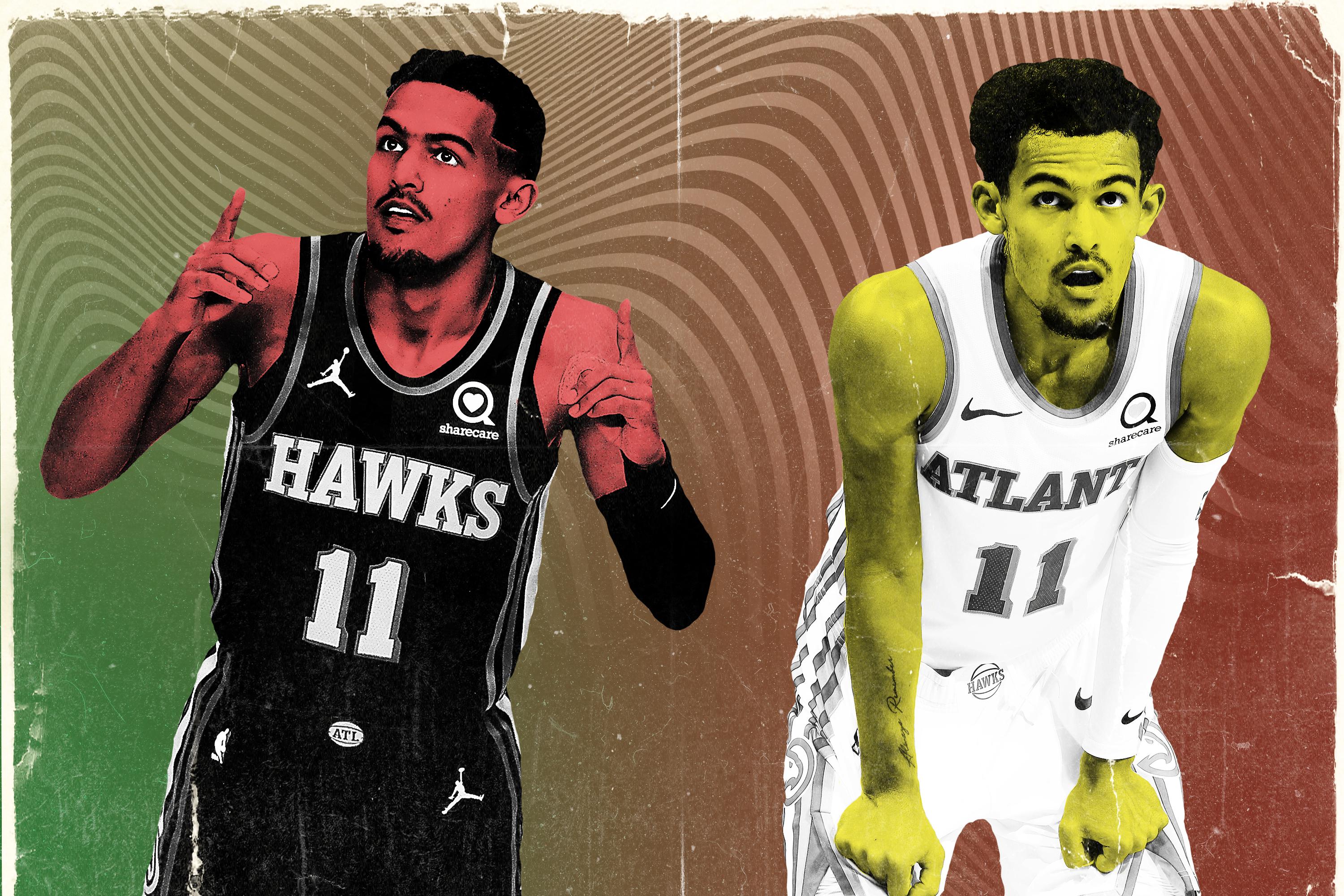
Some coaching changes are intended to transform a team. Others are simply meant to remind them of what they were always supposed to be. The Hawks opted for the latter when they fired Lloyd Pierce at the end of an underwhelming February and installed Nate McMillan as his replacement. Promoting the previous coach’s top assistant isn’t exactly a gesture toward radical change, and neither is choosing McMillan for the job. The great virtue of his head-coaching career—now spanning two decades across four franchises—is its professionalized stability. Hell or high water, McMillan will make a loose assemblage of basketball talent play like an NBA team. You can keep your revolutions; there are help-side rotations to nail down and games to put away.
Unsurprisingly, McMillan has the young Hawks on a steady march (or flight?) toward competence, with a 16-5 record in his tenure achieved largely by beating the sorts of teams Atlanta should beat but hadn’t previously. The wins the Hawks pulled off this week were beyond them a few months ago; this is now a club that can deliver a winning streak on the road, missing not only Trae Young and John Collins but six key rotation players in total. (Seven if you count Kris Dunn, who has yet to appear in a game for Atlanta this season.) Getting by without that much shot creation wouldn’t be possible unless a team is practiced in its ball movement, which is to say it wouldn’t be possible without a confidence in the designs McMillan brought to bear.
“It’s really difficult to try to win games [while] you’re developing a young group,” McMillan says. “They have to understand what is needed to take that next step. Sometimes you have to be a little harder, or you have to shorten your rope as far as what you allow to happen.”
Every developing team eventually has to confront some version of this same idea: Is the clearest way forward to give players more freedom or more structure? The answer very much depends on the people involved. Not all “young talent” functions the same; the needs of a team run by a 19-year-old point guard might be dramatically different from one relying on a 19-year-old center. Atlanta’s roster has youth all over, but having experienced a kind of freedom under Pierce and a different discipline under McMillan, the team’s record speaks—loudly, emphatically—to their apparent need.
“One of the things I talk about with our guys is getting organized,” McMillan says. It’s a simple idea that can easily slip away in the flow of the game if you let it, when a long defensive rebound leads to an almost-fast break and then some improvised attempt at offense with no one quite positioned as they should be. Even for a team with gifted playmakers (Young especially), those sorts of runaway possessions fed into the Hawks’ worst instincts.
“If we rebound the basketball and we push and advance,” McMillan says, “I tell our guys: Play early or play late. What I mean by that: If we can advance the ball and you can get an uncontested shot with 20 on the clock, I’m OK with that. If you can get a rim attempt, we want that. But we don’t want to come down and just jack contested shots early in the clock.” With that restraint, the Hawks have managed to play to both ends of the shot clock spectrum at once—their initial breaks are more selective and thus more efficient, and their longer, settled-down possessions are more coordinated and thus more effective.
These are situations when a less experienced team can benefit from firmer guidelines. McMillan calls more plays, on balance, than Pierce did, and he’s more proactive about using timeouts to straighten out the details of Atlanta’s play. (Perhaps a stricter framework of play means there are more details to consider.) Easing the Hawks into the middle of the shot clock and systematizing the way they operate gives a bit more shape to what’s going on away from the ball. Under Pierce, it was too easy for the shooters on the weak side of the floor to idle in their spots while Young and Clint Capela worked the pick-and-roll. Young actually has the ball in his hands even more under McMillan according to NBA Advanced Stats, but he’s using that time differently when he’s waiting for Kevin Huerter to clear a screen for an open 3 instead of pounding his dribble to dictate the action himself.
“I think right away it was tough to put in a lot of his offensive sets and defensive schemes,” Huerter says of the coaching transition. “But I think over the past couple weeks and month, you’ve seen a little bit of a different offense—a little more catch-and-shoot, a little bit more off-ball movement, which has helped guys like myself and [Bogdan Bogdanovic], and when [De’Andre Hunter] gets back and Tony Snell getting his shots. I think that’s been a big difference.”
Young is still the undisputed anchor of the offense, though Atlanta has evolved to the point that it can survive his occasional absences. The more the Hawks relied on Young to steer their possessions at the start of the season, the more hopeless they were in seeking any recourse without him. Young’s auteur style didn’t exactly help matters; McMillan has characterized his star guard as a player so talented he sometimes makes life on the court more difficult than it needs to be—taking traps head-on when he should pass out of trouble and trust his teammates.
The Hawks are now building that trust through prescription. When offense is left to feel and chance, there’s always a risk that some player or another will get lost in the vagaries of the process. That was often the case with Bogdanovic at the start of the season, when his versatility played instead as anonymity. To bring his game to the forefront, McMillan worked in sets specifically to empower him. “I had a chance to know him before when I was in Europe, and he was already one of the main scorers of his national team by doing what he does here,” Capela says of Bogdanovic. “It’s just amazing. I was so excited whenever he signed with us because I knew how efficient he could be.”
Capela, who is often tasked with screening off defenders to spring his teammates free, has noted that opponents have begun shifting their coverage to account for the threat of Bogdanovic’s jumper. Containing Young, Collins, and Capela already requires a scouting report in and of itself. When the Hawks make room for Bogdanovic, who joined Atlanta on a four-year, $72 million deal last offseason, to have a consistent presence in the offense (and when he’s shooting 53 percent from behind the arc, as he is this month), they have the balance to invalidate an opponent’s entire defensive game plan.
These issues are more complex than whatever differences exist between Pierce and McMillan; Bogdanovic, for one, came into the season off a bout with the coronavirus and left the lineup with a knee injury before he could find his way. Young’s intended backup, Rajon Rondo, bounced between being unavailable and ineffective until he was traded to the Clippers. After Hunter emerged as one of the team’s most important and reliable two-way players, he missed the entire month that would seal Pierce’s fate. So it went with injuries up and down the roster, as Pierce was rarely allowed the benefit of actually coaching the team he was promised. It’s telling, however, that the same could be said of McMillan, only with a dramatic difference in result. Only in the past month have the Hawks managed to finally play to their depth. This was a roster that could theoretically survive the absence of Hunter or Cam Reddish, or apparently both at once. There were enough options to get by without Danilo Gallinari, which we know now as the Hawks have gone 3-1 in McMillan’s tenure without him.
Atlanta played much of this season like a team at a deficit, a team without answers. The clarity of McMillan’s designs—even when they’ve come with more restrictions—have allowed a similarly shorthanded team to find a workable alignment. The Hawks were without so many players in their win over the Raptors on Tuesday that Huerter couldn’t recall all the absences off the top of his head, rattling off a full starting lineup of injured teammates before blanking on Tony Snell, who leads the league in 3-point percentage and sat out with an ankle sprain. In a way, it didn’t matter.
“I think our depth is something we talked about really [since] the moment the season started,” Huerter says. “Right now it’s showing. We knew that a year like this, a COVID year, everybody at some point was gonna be either sick or banged up. We’ve played so many games in such a short amount of time that our depth is really showing right now. We go into every game and we’re confident we can win no matter who we throw out on the court.”
The less talent available, the more benefit can be drawn from structure. This is how McMillan teams have persisted through injury for years, buoying seasons on their continued survival. His teams stick to a straightforward base defense, built on containing the ball and keeping out of rotation as much as possible. The offense, while rigid in some ways, never really asks players to do more than they can—or should. “He makes it simple,” Bogdanovic says. “He says if you’re open, shoot it. Don’t hesitate. If you have a guy on you, drive, find the open man, and play simple basketball.”
You run the script, you make the read, and you grind it out. Brandon Goodwin can step into a starting role and manage that even in Young’s absence, and the recently acquired Lou Williams can fill in behind him and pick up right where he left off. Solomon Hill can step in as a starting power forward without weighing the lineup down. It’s no wonder the Hawks are beginning to find their calm. Even Atlanta’s late-game nightmares seem to have abated; after ranking 30th in fourth-quarter net rating under Pierce, Atlanta has posted the second-best mark in the final frame during McMillan’s time at the head of the bench. There is obvious value in a coach pulling the right levers at the right time; leaning on Gallinari to help close out games (and sometimes entire fourth quarters), for one, has made Atlanta a notably more flexible team. But so much of the Hawks’ recent success comes from the certainty of structure, and the safety in knowing where the guardrails are.

